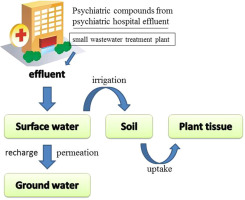Ecotoxicology and Environmental Safety ( IF 6.8 ) Pub Date : 2018-01-04 , DOI: 10.1016/j.ecoenv.2017.12.049 Jiajia Xiang , Minghong Wu , Jianqiu Lei , Chao Fu , Jianzhong Gu , Gang Xu

|
Psychiatric pharmaceuticals are gaining public attention because of increasing reports of their occurrence in environment and their potential impact on ecosystems and human health. This work studied the occurrence and fate of 15 selected psychiatric pharmaceuticals from 3 psychiatric hospitals effluent in Shanghai and investigated the effect of hospitals effluent on surface water, groundwater, soil and plant. Amitriptyline (83.57 ng ) and lorazepam (22.26 ng ) showed the highest concentration and were found frequently in hospital effluent. Lorazepam (8.27 ng ), carbamazepine (83.80 ng ) and diazepam (79.33 ng ) showed higher values in surface water. The concentration of lorazepam (46.83 ng ) in groundwater was higher than other reports. Only six target compounds were detected in all three soil points in accordance with very low concentration. Alkaline pharmaceuticals were more easily adsorbed by soil. Carbamazepine (1.29 ng ) and lorazepam (2.95 ng ) were frequently determined in plant tissues. The correlation analyses (Spearman correlations > 0.5) showed the main source of psychiatric pharmaceuticals pollutants might be hospital effluents (from effluent to surface water; from surface water to groundwater). However, hospital effluents were not the only pollution sources from the perspective of the dilution factor analysis. Although the risk assessment indicated that the risk was low to aquatic organism, the continuous discharge of pollution might cause potential environment problem.
中文翻译:

精神科医院出院的精神科药物的命运和风险评估
精神药物由于其在环境中的发生及其对生态系统和人类健康的潜在影响的报道越来越多,因此受到了公众的关注。这项工作研究了上海3家精神病医院废水中15种选定的精神药物的发生和命运,并研究了医院废水对地表水,地下水,土壤和植物的影响。阿米替林(83.57 ng )和劳拉西m(22.26 ng )浓度最高,并且经常在医院污水中发现。劳拉西m(8.27 ng ),卡马西平(83.80 ng )和地西epa(79.33 ng )在地表水中显示出较高的值。劳拉西m的浓度(46.83 ng )中的地下水含量高于其他报告。根据非常低的浓度,在所有三个土壤点中仅检测到六个目标化合物。碱性药物更容易被土壤吸收。卡马西平(1.29 ng )和劳拉西m(2.95 ng )通常在植物组织中确定。相关分析(斯皮尔曼相关系数> 0.5)表明,精神药物的主要污染物来源可能是医院废水(从废水到地表水;从地表水到地下水)。然而,从稀释因子分析的角度来看,医院废水并不是唯一的污染源。尽管风险评估表明对水生生物的风险较低,但持续排放污染可能会引起潜在的环境问题。


























 京公网安备 11010802027423号
京公网安备 11010802027423号